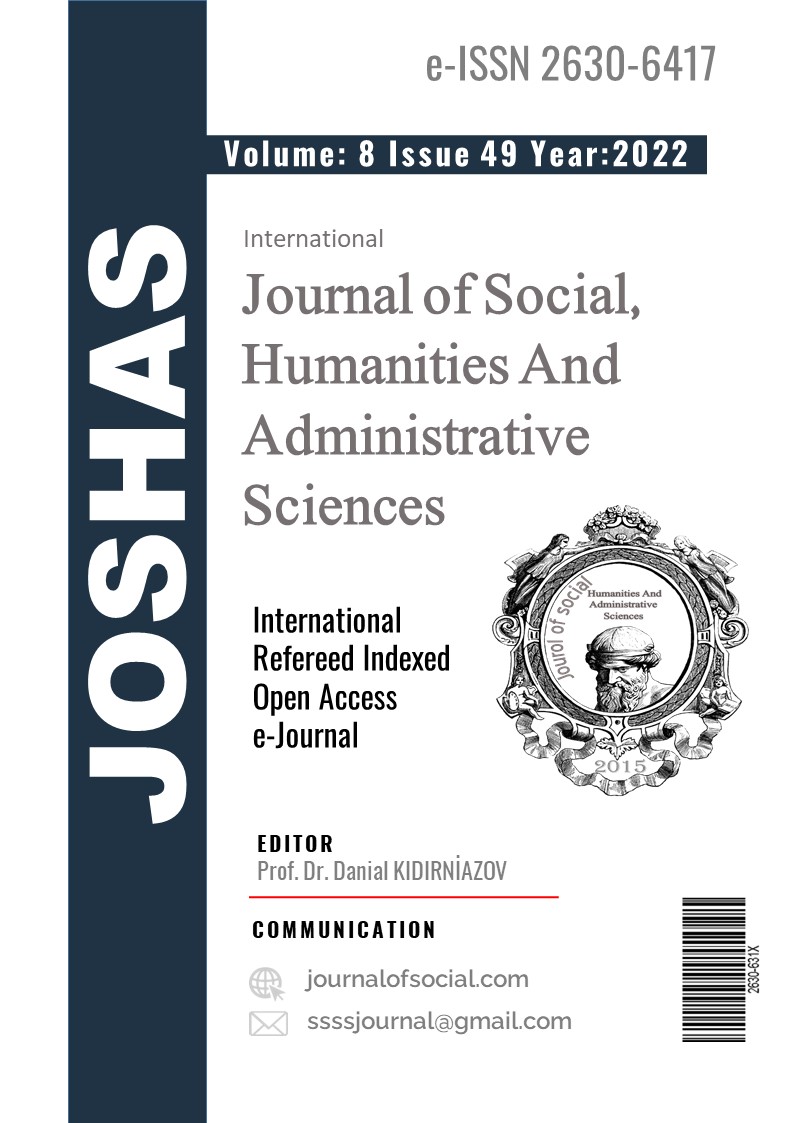Author :
Abstract
Bu makalede, Türkiye'de enflasyonun iktisadi büyüme üzerindeki etkisi ampirik bir uygulama yapılarak incelenmiştir. Çalışmada, 2001-2019 yılları arası zaman serisi verileri kullanılmıştır, Seri değerlerinin birim kök özelliğinin test edilmesinde Augmented Dickey-Fuller tekniği uygulanmıştır. Enflasyon ile iktisadi büyüme arasındaki nedensellik ilişkisinin belirlenmesi için Granger nedensellik testi yapılmıştır. Birim kök testi sonuçları modelde yer alan tüm değişkenlerin I(0) düzeyinde durağan olduğunu göstermiştir. VAR modelinde nedensellik analizi sonuçları, iktisadi büyümenin enflasyona neden olmadığını, ayrıca enflasyonun iktisadi büyüme üzerinde olumlu bir etkisi olmadığını ortaya koymuştur, Literatürde enflasyonun, teorik olarak üretkenliği ve çıktı düzeyini artırdığı düşünülse de, toplam faktör verimliliği açısından negatif bir etki yarattığı bulgusu elde edilmiştir. Bu sebeple, bir ekonominin iktisadi büyüme açısından sergilediği performansı, ülke ekonomisindeki enflasyon oranına bağlanamaz. Bu sonucun önemli bir politika çıkarımı, politika yapıcıları tarafından uyumlu bir çaba gösterilmesi gerektiğidir. Mal fiyatlarını düşürmek için üretkenliği / arzı artırmak, iktisadi büyümeyi hızlandırmak, çıktı seviyesini (GSYH) artırmak suretiyle enflasyon kontrol altına alınabilir ve arzu edilen en düşük seviyeye düşürülebilir.
Keywords
Abstract
This study examines the effect of inflation on economic growth in Turkey by making an empirical application. In the study, time series data from 2001-2019 were used. Augmented Dickey-Fuller technique was applied to test the unit root property of the series values. Granger causality test was used to determine the causality relationship between inflation and economic growth. Unit root test results showed that all variables in the model were stationary at the I(0) level. The causality analysis results in the VAR model revealed that economic growth did not cause inflation, and that inflation did not have a positive effect on economic growth. Although other studies in the literature consider that inflation theoretically increases productivity and output, it has been found that it has a negative effect on total factor productivity with this study. For this reason, the performance of an economy in terms of economic growth cannot be linked to the inflation rate in the country's economy. An important policy implication of this result is that concerted effort should be performed by policy makers. By increasing productivity/supply, accelerating economic growth, increasing the level of output (GDP) to lower the price of goods, inflation can be controlled and reduced to the lowest desired level.
Keywords
- Afşar, A. (2018). Finansal Ekonomi, T.C.Anadolu Üniversitesi Yayın No:3787, s.89.
- Afşar, A. (2018). Finansal Ekonomi, T.C.Anadolu Üniversitesi Yayın No:3787, s.89.
- Alesina, A. Summers, L.H (1993), “Journal of Money, Credit and Banking”.Ohio State University Press. Vol.25 No:2. Pp.151-162.
- Başar, S. (2020). Makro İktisat, T.C.Anadolu Üniversitesi Yayın No:4000, s.8
- Berber, M., & Artan, S. (2004a). Türkiye’de Enflasyon-Ekonomik Büyüme İlişkisi: Teori, Literatür, Uygulama. Atatürk Üniversitesi İİBF Dergisi, 18, 103–117.
- Bocutoğlu, Ersan. (2011). Makro İktisat, Teoriler ve Politikalar, (14.baskı). Ekin kitabevi yayınları,Bursa. s.68
- Bullard, J. Keating, J. W. (1995). The Long-Run Relationship Between Inflation and Output in Postwar Economies. Journal of Monetary Economics, 36(3), 477–496.
- Davidson, R. and MacKinnon, J.G. (2004). Econometric Theory and Methods (Vol. 5). New York, Oxford University Press.
- Debelle, G and S Fischer (1994), “How independent should a central bank be?”, Conference Series 38, 195–225
- Dickey, D.A. and Fuller,W. A. (1979) “Distribution of the Estimators for Autoregressive Time Series with a Unit Root”. Journal of the American Statistical Assocation, 74, June
- Dickey, D.A. and Fuller,W.A (1981) “Likelihood Ratio Statistics for Autoregressive Time Series with a Unit Root”, Econometrica, 49,4..
- Dikmen, N. (2018). Ekonometriye Giriş Temel Kavramlar ve Uygulamalar. (4. Baskı). Seçkin Yayınevi. Ankara. s.255-334
- Engle, R.F and Granger, C.W.J. (1987): “Co-Integration and Error Correction: Representation, Estimation and Testing”, Econometrica, 55: 251- 276.
- Fisher, I. N. (1961). “A Bibliography of the Writings of Irving Fisher.” New Haven: Yale University Library.
- Fischer, S. (1993). The Role of Macroeconomic Factors in Growth. Journal of Monetary Economics, 32(3), 485– 512.
- Gabaçlı, Nihal (2020). “Paranın Miktar Teorisi üzerine ekonometrik inceleme: Türkiye Örneği”, İstatistik ve Uygulamalı Bilimler Dergisi, 1(1):52
- Güriş, S. Çağlayan, E. (2000). Ekonometri Temel Kavramalar. (1. Baskı). İstanbul: Der Yayınları s.135 Hamilton, A. (2001). “Exploding Inflation”. Zeal Intelegence,2001
- Hendry, D. and Juselius, K. (2001), “Explaning Cointegration Analysis:Part-II”, The Energy Journal, 22:76-80.
- Humphrey, T. M. (1974). “The Quantity Theory of Money: Its Historical Evolution and Role in Policy Debates Letter on Monetary Policy” Federal Reserve Bank Of Richmond Economic Review, Vol.60, May
- Karaca, O. (2003). Türkiye’de Enflasyon-Büyüme İlişkisi: Zaman Serisi Analizi. Doğuş Üniversitesi Dergisi, 4(2), 247–255.
- Kutlar, Aziz (2007). Ekonometriye Giriş. (1. Baskı). Nobel Yayınevi, Ankara.s.267
- Mankiw, N.G.(2004). Principles of Economics, Thomson South-Westrn, 4 bs, Ohio, USA.p.782 Melberg, H.O (1992).“Inflation: an overview of Theories and Solutions”.
- Phillips, A.W (1958). “The Relationship between Unemployment and Rate of Change in Money Wage Rates in the United Kingdom”. Economica 25,November.
- Pakdemirli, B. (2019) “Ar-Ge Harcamaları ve Büyüme: Tarım Sektörü Üzerine Ampirik Bir Çalışma” Türkiye Tarımsal Araştırmalar Dergisi, 2019, 6(3):345
- Faria, J. R., & Carneiro, F. G. (2001). Does High Inflation Affect Growth in The Long and Short-Run? Journal of Applied Economics, 4(1), 89–105
- Phillips, P.C.B and Perron, P. (1988) “Testing for a Unit Root in Time Series Regression”, Biometrica, 75.
- Odusola, A.F. Akinlo, A.E. (2001). “Output, Inflation, And Exchange Rate in Developing Countries:An Application To Nigeria”. The Developing Economics, XXXXIX-2,pp.199-222.
- Ojo, M.O. (2000). “The role of the Autonomy of the Central Bank of Nigeria (CBN) In Promoting Macroeconomic Stability”. Central Bank of Nigeria Economic and Financial Review, Vol.38, Number 1, March
- Romer, P.M (1990) "Capital, Labor, and Productivity." Brookings Papers Econ. Activity (1990), in press. TCMB, (2020) https://evds2.tcmb.gov.tr/index.php?/evds/serieMarket (erişim tarihi 13.11.2021)
- Terzi, H. Oltulular, S. (2006). Enflasyon-Büyüme Sürecinde Sabit Sermaye Yatırımları. Atatürk Üniversitesi İİBF Dergisi, 20(1), 1–18.
- TÜİK, (2020) www.tuik.gov.tr/ (erişim tarihi 13.11.2021.
- Ünsal, E.M. (2017). Makro İktisat, (11.bs), Murat Yayınları, Ankara, s.88.
- Yalta, A.T. Yalta, A.Y. (2019). Modern Makro Ekonomiye Giriş. (1 bs), Adres Yayınları, Ankara.s.430
- Yapraklı, S. (2007). Enflasyon ve Ekonomik Büyüme Arasındaki İlişki: Türkiye İçin Eş-Bütünleşme ve Nedensellik Analizi. Atatürk Üniversitesi Sosyal Bilimler Enstitüsü Dergisi, 10(2), 287–301.





